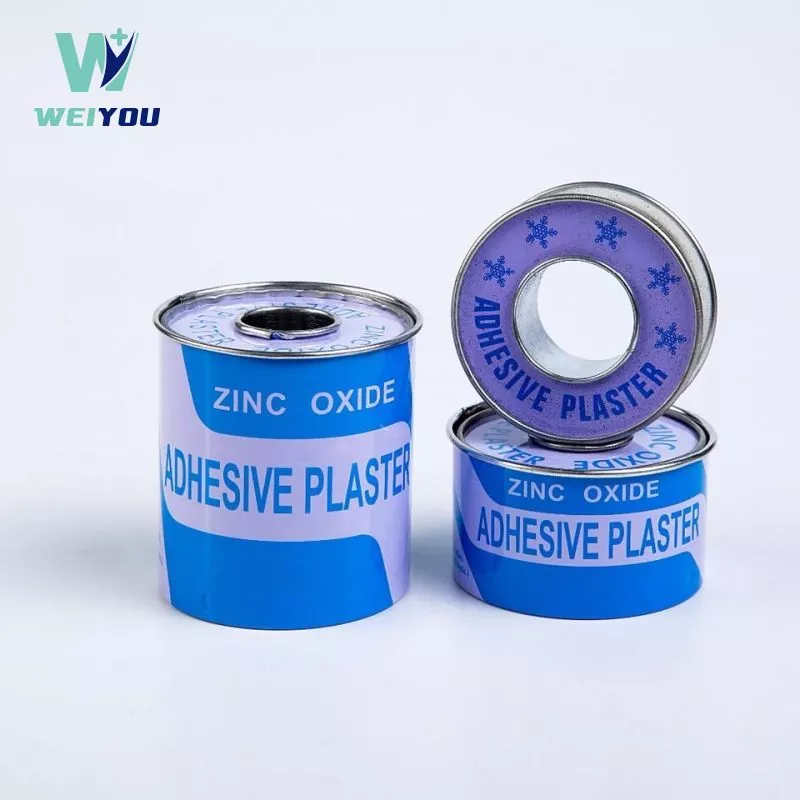- English
- Español
- Português
- русский
- Français
- 日本語
- Deutsch
- tiếng Việt
- Italiano
- Nederlands
- ภาษาไทย
- Polski
- 한국어
- Svenska
- magyar
- Malay
- বাংলা ভাষার
- Dansk
- Suomi
- हिन्दी
- Pilipino
- Türkçe
- Gaeilge
- العربية
- Indonesia
- Norsk
- تمل
- český
- ελληνικά
- український
- Javanese
- فارسی
- தமிழ்
- తెలుగు
- नेपाली
- Burmese
- български
- ລາວ
- Latine
- Қазақша
- Euskal
- Azərbaycan
- Slovenský jazyk
- Македонски
- Lietuvos
- Eesti Keel
- Română
- Slovenski
- मराठी
- Srpski језик
How to Remove Medical Tapes and Plasters Painlessly and Safely?
2024-10-08

What are the different types of medical tapes and plasters?
Medical Tapes and Plasters come in many different varieties, each suited for different purposes. Some of the most common types include:
- Zinc Oxide: This type of tape is very strong and is often used to secure heavier dressings or for sports injuries.
- Transpore: A transparent tape that is very breathable, making it great for long-term use or for sensitive skin.
- Cloth: This tape is made of woven fabric, which makes it more flexible and comfortable than other types of tape.
- Plastic: Very thin and flexible, this type of tape is great for securing light dressings or for use on children.
What are the best tips for removing medical tape and plasters?
Removing medical tape and plasters can be painful and difficult, especially for those with sensitive skin. Here are some tips to make the process easier:
- Use oil or adhesive remover: Applying oil or adhesive remover can help loosen the tape and make it easier to remove.
- Remove slowly: Pull the tape off slow and steady, as opposed to attempting to remove the entire thing at once.
- Warm it up: Warm up the adhesive prior to removal by pressing a warm towel or washcloth to it for a few minutes.
- Ask for help: If the tape is in a hard-to-reach area, ask for assistance in removal from a medical professional or caregiver.
What are the potential risks of using medical tapes and plasters?
Although medical tapes and plasters are generally safe for use, there are some risks to be aware of. These include:
- Skin irritation: Adhesives can cause skin to become red and irritated, especially if left in place for an extended period of time.
- Allergic reactions: Some people may be allergic to the adhesive used in certain types of tape and plasters.
- Wound irritation: If the adhesive is applied too tightly, it can cause irritation to the underlying wound.
Overall, medical tapes and plasters are essential for proper wound care and healing. When used properly and removed safely, they can make the healing process more comfortable for patients.
Conclusion
Medical Tapes and Plasters are vital components in the healing process of wounds. Understanding how to properly use and remove them can be helpful for caregivers and patients alike. Always follow your healthcare professionals' advice when it comes to wound care as everyone's situation is unique.
Ningbo Weiyou Import & Export Co., Ltd. is a leading supplier of medical supplies, including medical tapes and plasters. We strive to provide high-quality products at affordable prices to our customers worldwide. For more information about our products and services, please contact us at dario@nbweiyou.com.
Scientific Research Papers
1. George EI, Sun D. Confidence Level Optimality for Bayesian Inference with Nuisance Parameters. Stat Sin. 2012;22:1313–1334.
2. Lopes RD, Siha H, Fu Y, et al. Clinical trial networks in cardiovascular disease in Brazil. Am Heart J. 2013;165:803-12.
3. Viktil KK, Blix HS, Moger TA, Reikvam Å. Polypharmacy as commonly defined is an indicator of limited value in the assessment of drug-related problems. Br J Clin Pharmacol. 2007;63:187–95.
4. Wei WJ, Mu R, Chen J, Studnicki J. Evaluation of personalized prognostic prediction models for six-month mortality of elderly people living at home or in nursing homes. J Med Syst. 2010;34:1151-62.
5. Metz CE. Receiver operating characteristic analysis: a tool for the quantitative evaluation of observer performance and imaging systems. J Am Coll Radiol. 2006;3:413-22.
6. Matyas BT, Stewart BT, Aaldering H, et al. A history of operational research in humanitarian assistance. J Oper Res Soc. 2014;65:499-513.
7. Bender R, Grouven U. Ordinal logistic regression in medical research. J R Coll Physicians Lond. 1997;31:546–51.
8. Sawhney R, Sebag-Montefiore D, Han C, Nisbet A, Norman A, Dearnaley D. What is the optimal radiotherapy schedule in the management of muscle-invasive bladder cancer? Int J Radiat Oncol Biol Phys. 2002;52:1115-9.
9. Califf RM, Zarin DA, Kramer JM, Sherman RE, Aberle LH, Tasneem A. Characteristics of clinical trials registered in ClinicalTrials.gov, 2007-2010. JAMA. 2012;307:1838-47.
10. Van Veldhuisen DJ, Poole-Wilson PA. The UK heart failure audit: a well-timed reality check. Lancet. 2013;383:1123-6.



